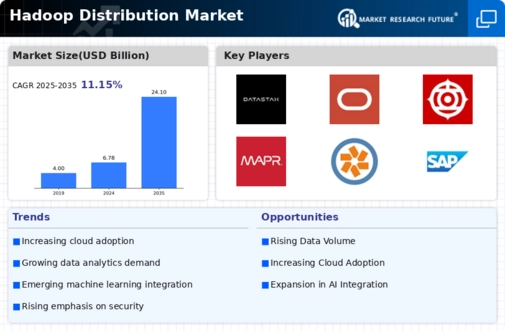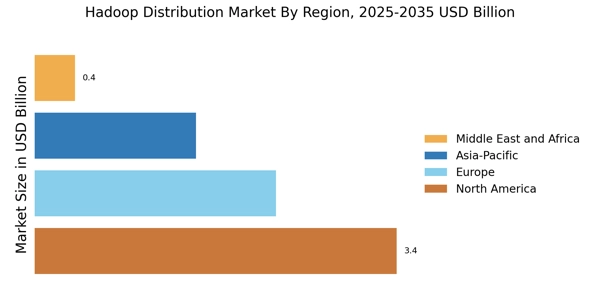The Hadoop Distribution Market is currently characterized by a dynamic competitive landscape, driven by the increasing demand for big data analytics and cloud computing solutions. Major players such as Cloudera (US), IBM (US), and Amazon Web Services (US) are strategically positioning themselves through innovation and partnerships. Cloudera (US) has focused on enhancing its data platform capabilities, while IBM (US) emphasizes its hybrid cloud solutions to integrate Hadoop with existing enterprise systems. Amazon Web Services (US) continues to expand its cloud offerings, leveraging its extensive infrastructure to provide scalable Hadoop solutions. Collectively, these strategies not only enhance their market presence but also foster a competitive environment that encourages continuous improvement and technological advancement.
In terms of business tactics, companies are increasingly localizing their operations and optimizing supply chains to better serve regional markets. The Hadoop Distribution Market appears moderately fragmented, with a mix of established players and emerging startups. This structure allows for diverse offerings and competitive pricing, although the influence of key players like Microsoft (US) and Google (US) remains substantial, as they leverage their technological prowess to capture market share.
In August 2025, Cloudera (US) announced a strategic partnership with a leading AI firm to integrate machine learning capabilities into its Hadoop platform. This move is significant as it positions Cloudera to offer enhanced analytics solutions, catering to the growing demand for AI-driven insights in various industries. The partnership is likely to attract new clients seeking advanced data processing capabilities, thereby strengthening Cloudera's competitive edge.
In September 2025, IBM (US) launched a new version of its Hadoop distribution, which includes enhanced security features and improved data governance tools. This development is crucial as it addresses the increasing concerns around data privacy and compliance, particularly in regulated industries. By prioritizing security, IBM not only meets market demands but also differentiates itself from competitors, potentially increasing its customer base.
In October 2025, Amazon Web Services (US) unveiled a new pricing model for its Hadoop services, aimed at reducing costs for small to medium-sized enterprises. This strategic adjustment is indicative of AWS's commitment to democratizing access to big data technologies, allowing smaller players to leverage Hadoop without significant financial barriers. Such initiatives may reshape competitive dynamics, as they encourage broader adoption of Hadoop solutions across various sectors.
As of October 2025, the competitive trends in the Hadoop Distribution Market are increasingly defined by digitalization, sustainability, and the integration of artificial intelligence. Strategic alliances are becoming more prevalent, as companies recognize the value of collaboration in enhancing their technological capabilities. Looking ahead, it is anticipated that competitive differentiation will evolve, shifting from traditional price-based competition to a focus on innovation, technological advancements, and supply chain reliability. This transition underscores the importance of agility and responsiveness in a rapidly changing market.


















Leave a Comment